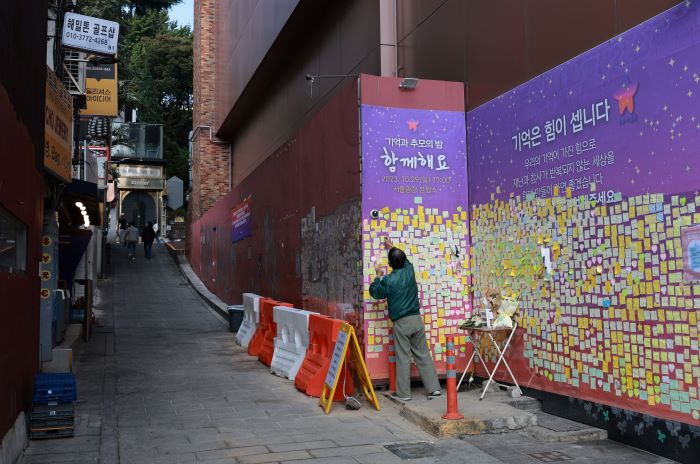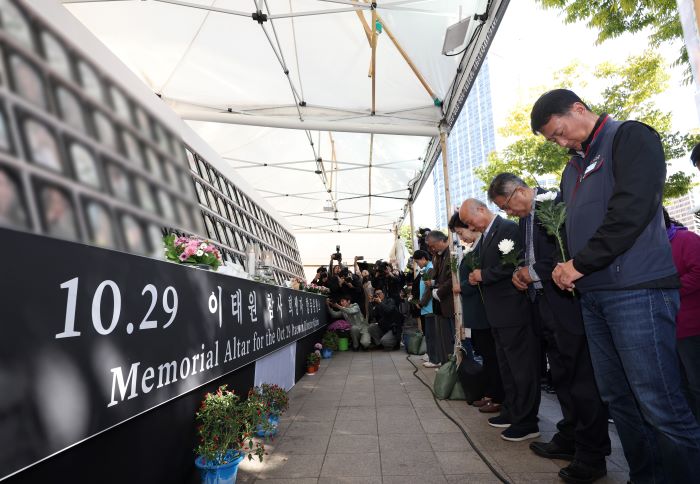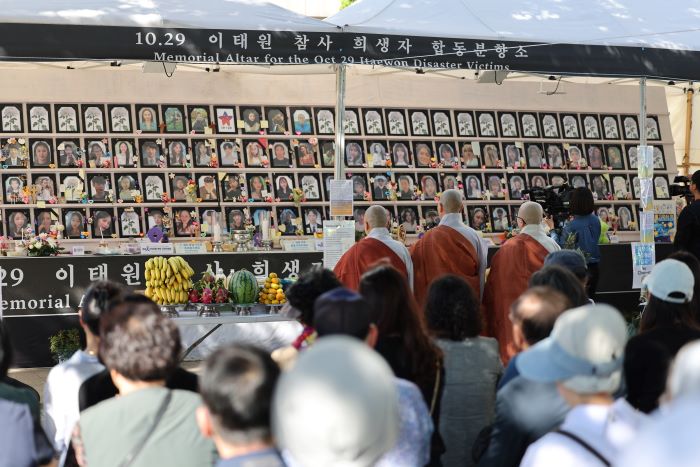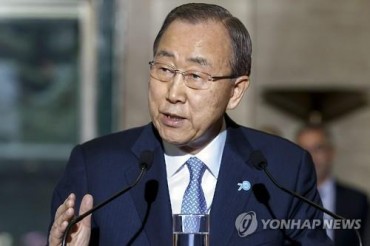SEOUL, Oct. 22 (Korea Bizwire) – A year after the deadly crowd crush in Seoul’s Itaewon district that claimed 159 lives, survivors and bereaved families still seek the truth behind the bungled disaster response and a proper closure to their loss.
The crowd crush, the deadliest ever in South Korea, took place in the nightlife district of Itaewon on Oct. 29, 2022, a Saturday night when about 100,000 people flocked to the area for Halloween celebrations.
Victims were crushed to death in a narrow 3.2-meter-wide downhill alley, where a massive crowd surged in and packed the path, piling onto one another. The accident was the worst disaster the country had seen since the sinking of the passenger ferry Sewol in 2014 off the southern coast, which killed 304 people.

A man puts a mourning message for victims of the 2022 deadly crowd crush in Seoul’s Itaewon on a board set up at the site of the accident on Oct. 15, 2023, ahead of the tragedy’s first anniversary. (Yonhap)
For survivors and bereaved families, the tragedy from a year ago is far from over.
A mass mourning altar hung with portraits of the dead victims maintains its presence at a corner of the public grass plaza in front of Seoul City Hall, as bereaved families continue to call for the passage of a special law addressing the deadly accident.
“A year has already passed since the horrible memory, but not a single piece of truth has been disclosed properly, while no one has been punished yet,” Lee Jung-min, a representative of bereaved families said, lamenting that the tragedy is vanishing fast from public memory. Lee lost his then 28-year-old daughter to the crowd crush.
“Things that are enjoyed by people in normal everyday lives, like happiness or warmth, are all gone for us.”
Lee and some 100 other bereaved families want the passage of the special law mandating an independent counsel investigation into what went wrong and who was responsible for the deadly incident before the end of the year.

Bereaved families of those killed in the 2022 crowd crush pay silent tributes at a mass memorial altar in central Seoul on Oct. 16, 2023, ahead of the tragedy’s first anniversary. (Yonhap)
Currently, trials are under way for multiple police, firefighting and ward office officials indicted on charges related to the bungled disaster and first-aid response, including Yongsan Ward office chief Park Hee-young and former Yongsan Police Station chief Lee Im-jae.
Investigations have shown that 87 emergency calls urgently seeking help on the night of the tragedy went largely neglected and no prior disaster prevention measures were taken for the weekend’s mass Halloween celebrations, suggesting the tragedy was “man-made.”
“We’re hoping that the legislation will pass within this year in order to seek the truth behind the tragedy and help victims, especially those who did not receive any substantial aid, be properly compensated,” Cho In-young, a lawyer supporting the bereaved families, said.
The tragedy catapulted South Korea into soul-searching about what went wrong and what should be done, and the government has since come up with a number of safety measures to prevent another such deadly accident.
Under the measures, regional governments are newly required to devise safety management plans for festivals or other mass public events to be held in their respective districts.
Harnessing information and communications technologies, a crowd management monitoring system will also be established to keep tabs on the density of crowds through surveillance cameras, and notify police and firefighters in the event of any danger.
By 2027, all regional governments nationwide will be required to operate a disaster situation room 24/7 and replace their surveillance cameras with AI-powered ones capable of crowd monitoring.

In this file photo, a mass commemoration service is under way on Sept. 29, 2023, for the victims of the 2022 crowd crush at a mass memorial altar in central Seoul. (Yonhap)
In the runup to the tragedy’s first anniversary this week, hotels, amusement parks and discount stores have decided to forgo Halloween marketing this year. Many Halloween partygoers are also planning to shift their celebrations to another popular nightlife district near Hongik University instead of Itaewon.
On the anniversary day next Sunday, bereaved families plan to mark the tragedy with a public mourning event in central Seoul that includes a march from Itaewon to Seoul City Hall and a mass rally in the evening.
Song Hae-jin, the mother of the 159th victim, said she wants many people to join the Sunday commemoration to “console one another and think about what we could do in our respective places to not be hurt again.”
Her son, a 16-year-old student, took his own life while grieving the death of two friends with whom he visited Itaewon on the night of the tragedy.
“I want more people to visit the accident site again and remember the people who were sacrificed there,” Lee said, adding, “Remembering is mourning.”
(Yonhap)






